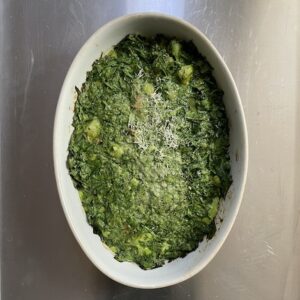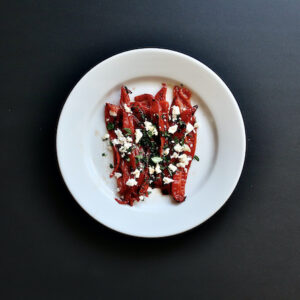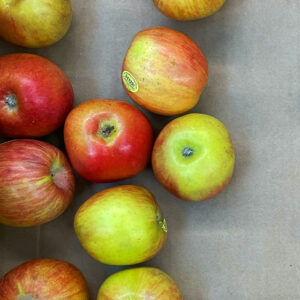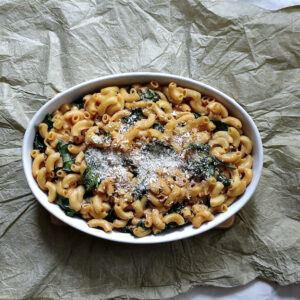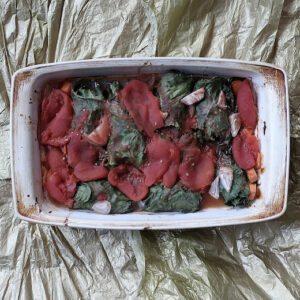In Chez Panisse Cooking, Paul Bertolli prepares artichokes by boiling them whole, then separating the hearts from the leaves. He-or, more likely, a sous chef–then scrapes the “meat” from each individual artichoke leaf, mixing it with chopped shallot, garlic, lemon juice, and olive oil.

The resulting artichoke mush may be eaten on toast or, and I quote: “can be used as the base of a risotto.”

The first time I read the above, I had never prepared risotto, artichoke or otherwise, and had no plans to do so. In fact, I rather feared risottos: they involved rice, and rice-making was a fraught endeavor.

As for scraping meat from cooked artichoke leaves, the very idea made me laugh hysterically, and not in a good way.

Cut to the present moment. Tasks like scraping artichoke leaves no longer induce disbelieving outrage. I have the news for that.

I am pleased to say scraping artichoke leaves is like peeling fava beans: once you find a rhythm, it goes quickly.

In fact, scraping three artichokes’ worth of leaves took around ten minutes, and I am hardly a rapid prep cook.

Leaf scraping.
Interlude
I realize some of you will never scrape artichoke leaves. You work. You have children. You think life is too (insert choice word here) short to scrape artichoke leaves.

The tasty bits scraped from artichoke leaves.
Where you live, fresh artichokes are hard to find, or only slightly cheaper than California real estate.

You can make artichoke risotto using frozen artichoke bottoms or jarred marinated artichokes. Lacking photos of these products, I give you the inedible choke, which must be removed and discarded. Below, some California real estate that is, indeed, extremely expensive. (It’s infill housing in downtown Berkeley.)

If artichokes are simply impossible, consider asparagus, which is just beginning to arrive at markets.

These are Chinese Golden Ear mushrooms. They cost $28.95 a pound, so I left them in the store. I did take a photo. I mean, we all know what asparagus looks like.
If none of these options appeal, use whatever fresh vegetable does.

Finally, if fresh artichokes are available but the idea of scraping leaves appals, don’t bother. Who will know?
Interlude concluded.
—
A few words on shopping for artichokes
Artichokes are a lot like cabbages…or people: damaged exteriors often conceal a intact interiors. Brownish leaves mean the plant was exposed to morning frost. This is a good thing.

Fresh artichokes are dry and should “scrunch” when picked up. A rotting artichoke is damp, with brownish grey patches.
Some artichokes sport sharp spines. Take care when handling these. They won’t kill you, but they will annoy. Who needs additional annoyances right now? And from an artichoke, of all things?
Artichoke stems are extensions of the heart. Trim the stem end and tough exterior, then treat the stem the same way you do the heart.

Rub artichokes with a cut lemon or toss them in water you’ve acidulated with a few teaspoons of mild vinegar. This said, any browning will vanish in cooking, so don’t worry about it.

—
About Risotto Rice

In explaining risotto rice, I defer to the late, great Marcella Hazan:
Choosing the correct rice variety is the first step in making one of the greatest dishes of the Northern Italian cuisine, Risotto. What a grain of good risotto rice must be able to do are two essentially divergent things. It must partially dissolve to achieve the clinging , creamy texture that characterizes risotto , but, at the same time, it must deliver firmness to the bite.
Essentials Of Italian Cooking, 30
Occasionally I’ve come across risotto recipes calling for whatever rice home cooks have around.
This is a bad idea.
Yes, risotto rice is more expensive than other types of rice. File this under you get what you pay for. Also know that “regular” rices don’t behave the way risotto rices do.
As a younger, less experienced cook, I tried making risotto using Basmati rice. The first time I used Lundberg, the second, Three Ladies, both excellent quality rices. Each time I ended up with overcooked rice in a soupy broth. Neither time was it risotto. Don’t be me.

No photos survive from either cooking failure.
I now make risotto using Lucedio Carnaroli risotto rice. It costs about $7 American for a 1.1 pound/500 gram box. In my house, a box is four dinners and two lunches. Hardly an enormous outlay.

Crummy photo, great product.
—
Artichoke risotto is not the moment for canned broth or bullion cubes with ingredient lists begining with “salt” and concluding with mumbling about GMO’s. I used homemade chicken broth, but vegetable broth is fine. The late Judy Rogers, writing in The Zuni Cafe Cookbook, says a good risotto is possible with water.
—
Anthony Bourdain, writing in the Les Halles Cookbook, describes chefs cooking risotto for restaurant service until half-done, then spreading it, “still pellet hard, to cool on sheet pans.” At dinner, when order for risotto came in, a line cook finished the dish.
If Bourdain’s chefs weren’t tied to their risotto pans, stirring continually, neither are you.

That said, now is not the time for your power walk. But you can leave the stove long enough to top up your Chardonnay.
Should you truly need to leave your risotto–see above examples–ladle about a half cup (120 ml) of broth over the rice. Turn the burner to its lowest setting. Take care of business. Return the heat to its former burble. Resume cooking.

Serve artichoke risotto with bread and a green salad, with parmesan cheese. Some people serve risotto on heated plates, but these people also have dishwashers.
Refrigerate any leftover cooked risotto quickly and consume it within three days. Rice is not a great keeper, and likes to collect unfriendly bacteria when left out at room temperature. So don’t leave it at room temperature. You have been warned.
In Italy, leftover risotto is made into suppli al telefono or arancini. See Canal House Cooks Everyday for recipes, or consult Marcella Hazan’s books.

Artichoke Risotto
Prep time: roughly 30-60 minutes to prepare the artichokes, depending on how big they are. Most of this is unattended cooking time, then about 25 minutes to make the risotto, which is active cooking time.
The artichokes may be prepared up to 5 days ahead of time.
Serves: 2-3 people as a main course, 4-5 as a side dish.
You will need a heavy, wide saucepan, saucier, or frying pan to make risotto. Enamel over cast iron is ideal. Ceramic or clay pots are also good choices. I use my Staub “Everyday” pan, which measures 14 inches/28cm across. A lid is helpful, but foil will work, too.
You will also need a 3-4 quart/liter pot, for the broth, a vegetable peeler, a serrated knife, and either a dinner knife or plain spoon.
As always, please see notes, below, before beginning to cook.
3 medium artichokes
approximately 2 tablespoons olive oil
1 tablespoon unsalted butter (optional)
1/4 cup/60 ml dry white wine or Vermouth
1-2 cloves garlic, peeled and minced
1 lobe shallot, peeled and minced
6 cups/1.5 liters unsalted chicken broth
2 cups/380 ml water, to top up broth
2 cups/380 grams risotto rice (I used carnaroli)
salt and pepper, to taste (I used white pepper; this is optional.)
Fresh lemon, to taste
Fresh parsley, optional
Parmesan cheese, to serve at table
Up to five days ahead of time:
Prepare the artichokes.
Either set up a steamer large enough to hold all three artichokes (or however many you have) or put a large pot of salted water to boil. If you are worried about artichoke browning (it disappears in cooking), add fresh lemon juice or a few drops of mild vinegar.
Using a serrated knife, cut the tops of the artichokes off. You want to get the sharp, pointy tips out of the way.
Now break the outer leaves off the artichokes. If you’ve never done this before, you’ll notice artichoke leaves are like asparagus spears: each breaks at a given point. You don’t have to force it. Break the artichoke leaves off all around each vegetable until you see the lighter green leaves. Discard these outer leaves, or put them in the compost.
Now trim the stalk, if there is one–sometimes markets cut stalks pretty close to the bottom of the choke. Trim the bottom off.
You can boil or steam the artichokes. I boiled them, which took about 40 minutes. In my experience, it is impossible overcook an artichoke: it will fall apart after a while, but that’s all.
Artichokes are done cooking when a tester easily pierces the heart or a leaf is easily pulled free.
Place either artichokes upside down on a clean dishtowel or in a strainer. Allow them to cool.
At this point you can hold the artichokes up to five days.
If you plan to make risotto within 4 hours, it’s safe to leave artichokes out (unless it’s 100 degrees; use good judgement). Otherwise, let artichokes cool, then refrigerate in a covered container.
If preparing risotto now:
While the artichokes cool:
Peel and mince garlic and shallot. Set aside.
Place pots on stove. Add chicken broth and water to smaller pot, and turn heat to low so broth can warm gently.
Check the artichokes: if still too hot to handle, run them under cool water and pat dry with clean dishtowels or paper towels.
To scrape artichoke leaves, pull a leaf from the choke. You will be able to feel and likely see where the “meaty” portion of the artichoke leaf starts, at the bottom of the leaf, and where it tapers off, about halfway up. Lay the flat side of the dinner knife on the leaf’s midpoint, where the meaty bit ends. Gently scrape downward.
You won’t need to exert much effort to free a bit of greenish purple fluff. Don’t be discouraged: these bits add up. Toss it in your bowl. Keep going until you reach the translucent inner leaves covering the artichoke heart. These delicate leaves have no meat; don’t bother with them. Using the knife, spoon, or your clean fingers, carefully scrape out the hairy choke and discard it.
The artichoke heart may be sliced thinly or quartered; the choice is yours. Add it to the bowl of scraped meat and continue until all the leaves are done. Three artichokes weighing about 16 ounces/450g trimmed yielded 6 ounces/200 grams “meat.”
Prepare the risotto
If the broth isn’t simmering, turn up the heat just enough for broth to reach gentle simmer.
Now turn to your risotto pan. Pour about 2 tablespoons olive in it and the butter, if using.The bottom of the pan should be coated. Add more oil/butter if needed.
Turn the heat to medium low. You want to warm the olive oil/butter mixture gently.
Once the butter is melted/the olive oil is warmed, add the shallot and garlic. They should cook without browning; what Elizabeth David called “melting.” Cook for 2-3 minutes, stirring.
Now add the rice and the wine. Stir continuously, so the rice is coated in fat and wine. Nothing should brown, but the heat should be high enough to get the rice nicely heated. You should be able to smell the wine, which should be absorbed by the rice. Season with salt and pepper.
When you can make a track through the rice with your spoon, start adding broth, a ladleful at a time. My ladle holds 8 ounces/227ml, which works well with the pan I use. Add enough broth to “feed” the risotto without swamping it. If you were to stick your index finger into the risotto after a ladle of broth, the liquid level should reach just above your fingernail.
This is approximate.
Using a wooden or comparable spoon, stir gently. Constant stirring isn’t necessay, but hang around. Each time you can make a track in the rice without liquid filling it in, add another ladle of broth. Keep it up until the rice is done, which takes 20-35 minutes, depending on your rice. You’ll need to taste to know.
The rice is done when it’s soft but still has a bit of “bite” at its core. This doesn’t mean chewy. It means pleasantly textured, not cooked to baby food.
Once the rice is done, add the artichoke scrapings and heart. Stir well. Taste for salt and pepper. White pepper is nice for appearances, but not necessary. You might want to add a squeeze of lemon to the risotto. You might not.
Add a final ladle of broth. At this point the risotto can sit for 45 minutes if it must, though in an ideal world your husband is already parked in front of the hockey game awaiting dinner (Yeah, we eat with the tv on. But only during hockey season. Have I ever mentioned he was born in Canada? Really. He was.)
If you are holding the risotto, cover with a lid or foil and place over lowest possible heat. You can place the pan in the oven, too. Use the warming feature, if you have one, or use the lowest heat setting.
Serve Artichoke Risotto on hot plates (or don’t, if you’re me and can’t be bothered). Parmesan cheese and parsley are nice but unnecessary touches.
Leftover artichoke risotto should be refrigerated immediately and consumed within three days.
Rice doesn’t like hanging around at room temperature, and is not a good keeper. Consider yourself warned.
Notes
I realize artichokes are not widely available. If you cannot get three medium artichokes, buy whatever size is for sale. If you have a choice, smaller artichokes are better than larger specimens. If fresh artichokes are not available, frozen artichoke bottoms may be used. Bottled marinated artichoke hearts may be used as a last resort, provided you rinse them thoroughly before use. Otherwise you’ll end up with a risotto tasting of salad dressing.
Small artichokes don’t need scraping. Instead, trim them as needed, then halve or quarter them for ease of eating. Steam or boil them. They’ll cook in 20-30 minutes.
If you cannot or don’t want to use artichokes, consider asparagus, fresh or frozen peas, fava beans (or a combination of these vegetables). Or use your favorite vegetable.
Butter is used for flavor, but can be eliminated if you are cooking for vegans. This applies to the cheese and broth.
If you run out of broth before the risotto is finished cooked, top up with water.
Readers interested in rice in general and risotto in particular are directed to Jeffrey Alford and Naomi Duguid’s Seductions of Rice, Marcella Hazan’s Essentials of Classic Italian Cooking, Sri Owen’s The Rice Book, and Judy Rogers’s The Zuni Cafe Cookbook, which devotes a section to risotto making.
























